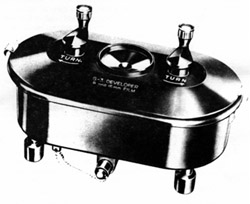

How to process movie film,
8mm-35mm
Yes, it's been done before - you can develop motion picture film without sending it to a lab. Will it be better for you? You'll have to find that out yourself by reading further. I myself have processed movie film years ago, before the web made it possible to learn about this subject. While I personally haven't developed any movie film in a while, I want to share with you what I've learned and make it easier for those who are interested in this intriguing subject. If you want to help keep movie processing alive and growing, join our Yahoo group (scroll down below) and share your experiences.
This information is all presented without any guarantee to accuracy or results, and without any liability for the use/misuse of the information here. Be careful with chemistry and hardware construction, take all possible safety precautions. I apologize for the impromptu scrapbook type of page design, I hope it's navigatable. Be sure to scroll to the very bottom for all the links. Enjoy!
|
Personal note, unrelated to movie processing: Please help save Serbian kids by supporting this charity effort. These children are victims of terrorism too, but are often forgotten by the world. To learn more on this horrible terrorism that continues to this day, click here.
Thank you! Please enjoy the rest of the site! |
This is a group devoted to those who want to share their movie processing experiences and learn more. You can upload photographs of your processing equipment as well as construction plans. You may not get email for a while, but if you drop a note someone else might answer you sometime later and you can begin a discussion. Do, however, read this page first, it will probably answer many if not most of your questions! Excerpts scanned from Kodak's publication H-7 (for developing black and white reversal/direct positive film)
IN GIF FORMAT
(c) Eastman Kodak Company
Many people have an idea, but few have the original specs from Kodak on how to develop your own black and white motion picture film. Here they are, no longer published or available by Kodak (they used to send this out for free to those who'd request it via mail) - so I am offering them to the internet community, painstakingly scanned (OCR didn't take, sorry). You can also use these instructions to develop negative film as reversal (as well as still film), best results are usually with slower speed films like 7231 (it's recommended the film speed be rated higher by one and one half a stop - you may have to test this).
- PAGE 1 Description and safelight recommendations
- PAGE 2 Description continued
- PAGE 3 Processing times for rack and tank and rewind gear
- PAGE 4 Notes on processing tables
- PAGE 5 Notes continued
- PAGE 6 Formulas
- PAGE 7 Formulas cont.
- PAGE 8 Formulas cont.
- PAGE 9 Formulas cont.
- PAGE 10 Troubleshooting
- PAGE 11 Troubleshooting cont.
- PAGE 12 Processing times and replenisher rates for continuous processors
- PAGE 13 Solution life
- ALL AT ONCE
|
MORE MOVIE PROCESSING ON THE WEB
There is quite a lot of information already out there on the web about developing movie film, below are links to various sites. One great and reliable source of information has been Martin Baumgarten, a gentleman who has been processing motion picture film commercially and as a hobby for many years. Martin has written lots on the subject on the internet, and you can read his postings archived on the Usenet if you do a search for "Martin Baumgarten" on Google (look at the menu bar right below the Google logo, and instead of "Web" select "Groups").
DIRECT FROM THE 8mm METADIRECTORY:
These pages are direct links to The 8mm Metadirectory - an excellent and comprehensive gathering of information regarding not only the 8mm film format, but filmmaking in general.
These specific pages, mostly authored by a very helpful motion picture processing guru, Martin Baumgarten (who also offers his own services for processing), are a bit hard to find on the Metadirectory, so I've decided to paste them directly here for instant access. They supercede any online info on movie processing I've ever encountered. This information can be applied to any format you are developing, not only Super 8:
ON REWIND MOVIE PROCESSING (INCLUDING COLOR) by Martin Baumgarten from "Shooting 8mm", a terrific Super 8 site. The Morse/Arkay/Doran G-3 rewind tank is probably the most easily obtainable processing device (Ebay almost always features one). It is time consuming to use but it can develop all widths of film (from 8mm to 35mm, including 9.5 mm for all you 9.5 enthusiasts), so long as they are no more than 100 feet in length.

ALSO from the "Shooting 8mm" site, see:
Misc:
